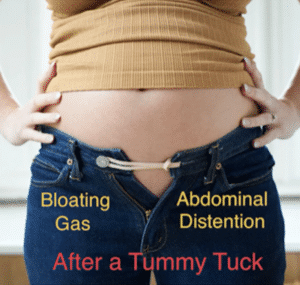Abdominal bloating, gas pain, and distention are frequently common and experienced by patients after a tummy tuck. Recovery from abdominal operations typically involves understanding and managing pain, bruising, swelling, and other symptoms after the surgery. Distention and bloating also occur commonly but are less frequently discussed. This educational writing will review this topic in detail about post operative recovery from tummy tuck. It was written at the request of a patient from Philadelphia, PA.
The recovery process and healing after cosmetic stomach surgery has been covered in other educational writings that I have posted. But a less common problem or symptom discussed after surgery is bloating and distention. It can be frustrating because the surgery is done to make the stomach flatter and smaller, not distended or bigger. But good news, it’s temporary and resolves relatively quickly.
What Does it Look Like?
Abdominal distention and bloating look like the abdomen is swollen and full on the inside. The fullness is not the bruising and swelling that are around the incision and the surgical site, but inside the abdominal cavity where the intestines and organs reside. It’s in the same location as inside fat versus outside fat. This topic is reviewed in another educational writing that I have written. The inside swelling is fluid, gas, and actual poop, called feces.
I have found that these symptoms of bloating, gas, and distention are most noticeable after tummy tuck operations than other cosmetic procedures. I believe this is because the flatter stomach makes normal gas and swelling more visible. It can increase anxiety because the patient wants a flat stomach and the swelling appears like it could ruin this result. Good news however. These problems never ruin the result. They are temporary and subside as healing occurs.
Why?
Why do we get these symptoms after surgery? There are multiple causes that include anesthesia, fluid retention, lymphatic drainage, and post surgical changes. Understand that these changes are normal and to be expected for most patients during the post operative period. They are part of the normal physiological process of healing. Surgery creates changes, and these symptoms are just part of the recovery process. Most people know that bruising and swelling are to be expected. Distention and bloating are other symptoms that just are not as commonly discussed.
Treatment :
The symptoms for most patients require no treatment. They will gradually resolve on their own. It takes time, but most people will have resolution over 4 to 8 weeks. If someone is having more symptoms than average, things can be done to help improve the gas and distention. These include hydration, walking, and stool laxatives and softeners. All these will greatly help you feel better.
In addition to the treatments mentioned above, stopping pain medications is definitely the most critical. Surgery typically requires narcotics to assist with pain management, and narcotics are well known to cause abdominal distention and bloating. Pain medications decrease intestinal motility, which means they shut the digestion of food down. It’s imperative to get off narcotics to treat the distention and promote normal bowel habits and bowel mobility.
Resolution and Clinical Coarse:
The distention usually quickly resolves as the patient heals from surgery. Often by a week or two after surgery, most symptoms have lessened or completely gone away. Complete resolution is typically over 3 to 6 weeks.
Summary:
Abdominal bloating, gas, and distention are common symptoms after cosmetic surgery and other operations. They are part of the normal physiology of healing. The symptoms can be worse for some patients more than others. Treatment such as hydration, walking, and laxatives often dramatically improve the problem. Stopping narcotics is critically important to help the intestinal tract get back to normal movement and motility. Surgical results and cosmetic outcomes are not effected from these symptoms. Patients can be relieved to know that things improve quickly and safely.



